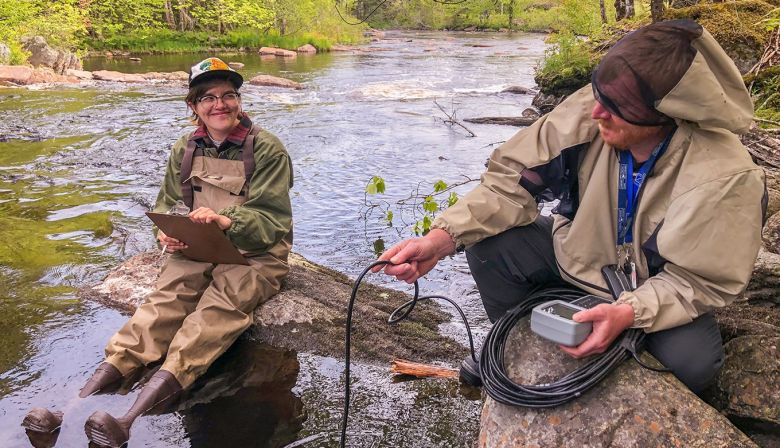MOSER RIVER – The Nova Scotia Salmon Association (NSSA) is promoting the management and conservation of wild Atlantic salmon and trout stocks in the province, work that includes Moser River in Halifax County.
“The objective of the project – Southern Uplands WATER project for Aquatic Species at Risk – is to restore the health of eight priority watersheds and to create watershed stewardship plans to guide future restoration in these watersheds,” Dr. Fielding Montgomery, NSSA research scientist, told The Journal via email.
Montgomery is the lead on the restoration planning project for Moser River.
The organization is in the data-collection stage to better understand and characterize the habitat conditions and species distributions within each watershed. They are completing field surveys and a local community knowledge survey to obtain information to help with their planning.
The Moser River watershed encompasses land where all brooks, streams, lakes and ponds drain into Moser River.
“The main reach of the Moser River is [about] 5km long, and the watershed is [about] 177 km2,” said Montgomery, “… and there are seven other watersheds we are focused on as well: Annapolis River watershed, LaHave River watershed, Medway River watershed, Petite Riviere watershed, Musquodoboit River watershed, St. Mary’s River watershed and West River, Sheet Harbour watershed.”
Ultimately, the type of restoration which will occur will depend on the type of stressors and habitat conditions in each watershed.
“For example,” explained Montgomery, “… if our field data and survey responses help identify a stretch of river that is highly impacted by acid rain but might otherwise support Atlantic Salmon, restoration could include liming.”
The first lime doser to be equipped in North America was on Sheet Harbour’s West River in 2005. The salmon population was declining due to acid rain and low pH levels. The doser has been successful in stabilizing the pH of the river to a level of 5.5, which is required for salmon to multiply and survive.
The research scientist says the objective of restoration of Moser River may also include in-stream activities that help improve the natural meandering of a straight, over-widened channel, to create important habitat pockets for spawning.
“Overall, the goal is to identify restoration activities that will improve poor quality habitat and enhance good quality habitat to support the survival and recovery of Atlantic salmon, American eel, Atlantic whitefish and a freshwater mussel brook floater. Ultimately, these restoration activities will benefit the aquatic and terrestrial ecosystem of each watershed.”
The NSSA is reaching out to fisherman and those who have canoed, kayaked, swam, fished or even ATV’d along the river to complete a survey allowing them to collect pertinent data.
Montgomery said, “We have put together a community outreach committee which is one or two representatives from each watershed and each representative is helping to spread the word in their local community. Anthony Heggelin is the Moser River representative.”
To get the request out for feedback the representatives, through local businesses, are handing out pamphlets, the survey and project information and posting on community Facebook pages.
“The survey can be found on our website nssalmon.ca/southernuplandssurvey but we can also print and distribute hard copies for those who want it,” offered Montgomery.
The association is specifically looking for information related to aquatic species, their habitat and history of the river. “For example,” she explained, “… where folks have seen certain fish – Atlantic Salmon, Brook Trout, American Eel, Atlantic Whitefish, Smallmouth Bass, Chain Pickerel and freshwater mussels.”
For those familiar with the area the survey includes questions such as: possible barriers for fish to pass through, such as the locations of beaver dams, waterfalls and culverts; locations of cold-water creeks; locations of eroding stream banks; major changes to the river over time; and major areas of development.
The planned timeline for conducting the survey and receiving as many responses back as possible is the end of April.
“The results of the survey might help us identify areas of interest we should follow up [on] and [include in] our in-field spring/summer data collection,” Montgomery said. “However, we are not closing the survey at that point as our project is set to end in 2023 and so we will be accepting responses for another year.”
Halifax Regional Municipality (HRM) District 2 Councillor David Hendsbee, who has been supportive of the initiative, told The Journal via e-mail: “I hope to see the Eastern Shore tributary rivers – like Tangier, West River, Moser River and St. Mary’s – rebound and, once again, become productive spawning grounds for the migrating Atlantic salmon.”
The project is funded by Canada Nature Fund, a federal four-year grant through the Department of Fisheries and Oceans Canada.
https://www.thestar.com/news/canada/2021/02/17/nssa-working-to-restore-moser-river.html
